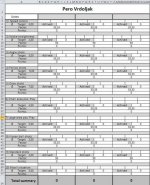tommy84...If you consider that a beginner drill, you must be a world class player yourself. As an instructor, I can easily say that at least 3/4 of all poolplayers would not be able to complete that drill, even once, without a significant amount of practice...AND an accurate, repeatable stroke (nothing of which was mentioned in the review of this class...to assume that all 8 participants had a quality stroke already, without some sort of video analysis is unlikely), and without hitting at least one of the OB's, as they're laid out in the OP.
I agree with the OP that even a player of Toasti's stature cannot manage working effectively with a group of 20...even for two days. We try to keep our student/teacher ratios to 3-1 or less, so that all students feel like they get enough one-on-one attention. If we had 8 students, we would likely have at least 3 instructors.
Scott Lee
www.poolknowledge.com
Scott knows of what he speaks on both counts. :thumbup:
I kept checking in with Shooters Billiards as the event drew near to see how many attendees there were going to be. I set in my mind that if it went over 10 (they were trying to get 20), I wasn't going to participate.
As it was, with 8 guys, it kept Thorsten extremely busy. He is a talented player who definitely understands all aspects of the various games and he proved that he can impart his knowledge to others with relative ease. With all of that said, and as I mentioned in a previous post how his training materials were so well prepared and meticulous, I believe we were at max capacity for everyone to feel they received a reasonable amount of individual attention. And as Scott pointed out, yes I agree, an extra one or two instructors would have been a plus.
As for the drill that I posted, again Scott, you are correct. While it may look relatively easy, it is very challenging. I never got past two successful runs through the five paths. We worked on that drill for approx 45 minutes.
Every one in the class found it very challenging. This is definitely not a low skill, beginner drill.
Best,
Brian kc
